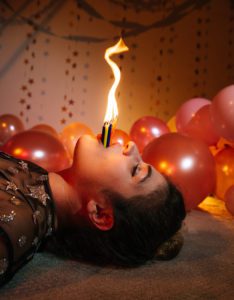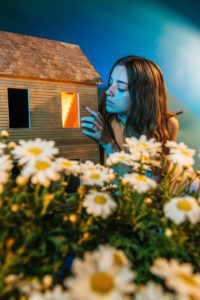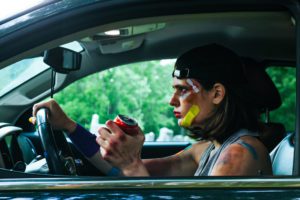Jaina Cipriano is a wearer of many hats: A filmmaker and set designer, photographer and installation artist, seeker of light and explorer of shadows. Her work can be seen as whimsical and optimistic or eerie and tortured depending on how you approach it, which she says is a feature, not a bug. The Lowell-based artist is currently showing a collection of photographs along with three interactive installations suffused with the symbols of childhood–birthday candles, playhouses, primary colors–at Boston University’s 808 Gallery. Viewers are encouraged to step into the role of photographer or model as they inhabit the spaces that comprise her Dreamscapes.
Nostalgia is a double-edged sword to Cipriano–the spaces she’s devised, both emotional and physical, have the power to wound as well as heal, and she doesn’t expect gallery visitors to give her work a unified response. Simply put, Dreamscapes is a transportive experience–though where it transports you is entirely up to chance.
Cipriano sat down with the BH to discuss her creative process, artistic intention, and her long journey toward the light.
Boston Hassle: So how did the camera fall into your hands?
Jaina Cipriano: I have been taking photos since I was a little baby. I just stole my parents’ Polaroid camera when I was a kid, and then used up all their film. And they were always really mad at me because film is really expensive. So I’d say “I’m sorry, I’m sorry,” and then I would just do it anyway. I was famous in my town; people were like, ‘Oh, you’re that girl who takes all the photos of everyone around town…’ I couldn’t stop myself. It just became a way that I saw the world. It was the way I met new people and made friends.It just was like a tool that I used that had a cool community element to it.
And after childhood?
I studied photography in school, I went to the New England School of Photography, which doesn’t exist anymore. I studied photography very much with the intent of becoming a photojournalist or documentary photographer. They teach you about photographers like Gregory Crewdson, and how he does huge movie sets, these really intricate photos. I was 20, or 21, and I was like “this is so stupid; if you’re gonna fabricate [your photos], then it’s not reality. It’s not true. It’s not real.’ I was really against things like that.”

So what did they have you doing instead?
There was a lot of pressure in school to do street photography. And I was like, I can’t do this. I don’t want to do this. This is very boring for me. There’s no connection here. I think connections are the really exciting part. When you build a space for someone, it’s so individualized. You really get to work with them in it, and in street photography, you’re a ghost.
Your early 20s are so turbulent. I think I started to crave control. I was in this terrible relationship and I got really isolated from everyone in my life. Going around and taking photos of people just wasn’t happening for me, so I started creating spaces and bringing people into those spaces.
What was your first set?
I had these nights at my apartment when I was 22, 23–I called them ‘immersion.’ I would build these spaces in my apartment for people to come into, and there were themed nights. We did a birthday party theme where I filled a room up to our chests with balloons. There was a cake-smashing room and a pile of presents. It was this low pressure space for everyone to come in and model or take pictures. I was just like, ‘oh, this is obviously what I love to do. This is so much more interesting than just taking photos. I really enjoy creating space.’ That was about five or six years ago, and at some point I just picked up a drill and I taught myself how to build things.
How do you go from creating a set to creating a whole world, or a whole reality?
When I bring people into the spaces I create, I really try to find a common emotional denominator between the two of us, something that needs to be exorcized or removed or seen.
And I’ll talk with my models beforehand about what we’re going for, so that way they can lose themselves in what they’re doing. I think it’s a really special space to bring out things that you’re wrestling with, or things you’re not sure of. When I’m able to pull those emotions out, that’s the world that we’re existing in, which is a real world. It’s just not the real world. It almost becomes performance art, but there’s really nobody there. Just me and my camera.
“For me, this work was really what pulled me out of a dark place. So I used the fuel of these horrible things that I had been trapped in for a long time to get to the other side. I followed the light through it.”
And you don’t retouch any of your photos, right?
I think that the reason that my work works is because I like to put emotion into my models. I think that if I was photoshopping them into the spaces, the images would feel really different.
I shoot with hot lights; I don’t shoot with a flash. It’s very much like you’re on stage. My motto is ‘I can’t see you through the lights,’ which I think is good. I don’t really want them to see me. I want them to be able to fall back into the space.

What are some of the emotions that go into the installations at Dreamscapes?
Two of them are a play on domestic spaces and childhood, and then the other one is just an overwhelming explosion of light–coming through darkness in these spaces and finding the lights. You can be either me or the other person in this scenario. You can be the maestro and conduct whatever scene you want, or you can be the model. And you can fall into the space yourself. But all of the spaces are meant to be interacted with.
Your work gets described as really whimsical and joyful, and also dark and painful, kind of in equal measure. How do you account for that polarity?
None of those emotions are exclusive. I think that’s what is so difficult about being a human– trying to be present and alive in your body and in time as all of these emotions exist simultaneously. It can be really loud and confusing. For me, this work was really what pulled me out of a dark place. So I used the fuel of these horrible things that I had been trapped in for a long time to get to the other side. I followed the light through it.
I think a lot of times these spaces that I build are a projection of some feeling or experience that I wasn’t able to either describe or grab onto, and it just kind of nags at me. So I create this visual space and it’s nice to go into those spaces myself and be like, what’s going on here? What’s going on inside me? My therapist would have a field day with that.
The 808 Gallery (808 Commonwealth Avenue, Brookline, MA 02215) is open Tuesday-Saturday from 11 am to 5 pm; admission is free. Dreamscapes is on display until Oct. 13.
Jaina Cipriano’s short film, Trauma Bond, premieres at the Regent Theater (7 Medford St, Arlington, MA 02474) on Oct. 25, in partnership with Women in Film and Video New England; a panel discussion will follow.


